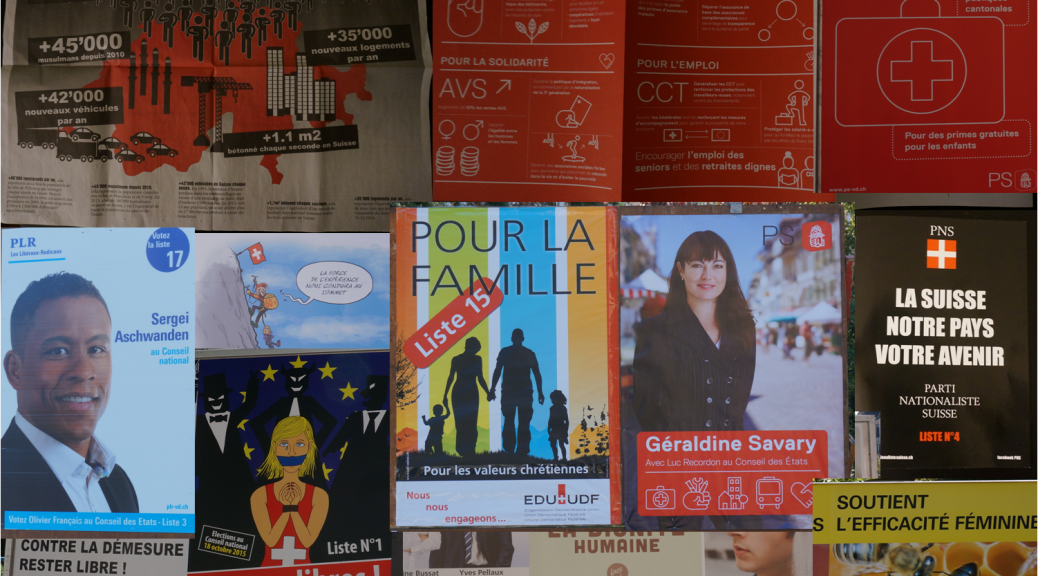In the United States the second of many presidential debates was held last week. In Switzerland the citizens are also getting ready for an election that only happens once every four years. Less than a month away, on October 18th, all the seats in both of Switzerland’s federal legislative houses are up for election But it was only this week we realized it when we started noticing campaign posters, and flyers in the mail. As I did some research I found the shorter campaign season, and lack of constant political coverage aren’t the only things different in the two democracies.
To start, Switzerland has three levels of government. One federal government, broken up into 26 cantons, which are further broken up into a total of 2324 municipalities. At the municipal level the big difference is that roughly 80% are run by direct democracy. Instead of a city council, a chairperson runs the meeting and all decisions are made by vote, by any citizen that wants to attend the meeting. This practice is carried up to the canton level in just two cantons. The rest function similar to a state government in the U.S., but with only one house of parliament.
At the federal level there are two houses. The 200 seat National Council, where seats are distributed by population, and the 46 seat Council of States, where seats are distributed evenly to the cantons. Bills can be drafted in either house, and then for the bill to turn into a law, both houses need to pass it by vote. However, Switzerland loves direct democracy, if people don’t like a recently passed law it can be put to a popular referendum if 50,000 signatures can be collected within 100 days of its passing. There is also a way for any citizen to come up with their own law. All that is required is 100,000 signatures within 18 months and a citizen proposed law, called a popular initiative, will be put to a popular vote. These referendum votes are held four times a year, and on average have three or four proposals.
Even though the Swiss love voting, strangely the executive branch of government is not voted on by the populace. I write executive branch instead of president, because Switzerland has a very unique system where the executive power rests in a federal council of seven members. Federal council members are elected by a joint session of both houses for four year terms, that overlap so that not all seven come up for election at once. Each council member runs a federal department, (similar to a cabinet position in the U.S.), and executive decisions are determined by the council in secret meetings. There is a designated president and vice president of the council who serve for one year terms, but it is a largely ceremonial position that cycles through all the council members.
Something else different than the U.S. is the number of political parties. Currently there are eleven parties represented in the federal legislature. The party with the most seats, 54 out of 200 in the National Council, and 5 out of 46 in the Council of States is the Swiss People’s Party. The Swiss Peoples Party advertises the most, and is pushing an anti-immigration platform hard. Their other policies are conservative, and isolationist.
The Social Democratic Party has the second most seats, 46/200, and 11/46. I would say their positions are slightly left of U.S. democrats, but similar to Bernie Sanders’s. They are one of the only parties to support EU membership, and their “liberal” idea for immigration is to allow naturalized citizenship to 3rd generation people born in Switzerland.
Next is a party called “FDP. The Liberals” holding 30/200 and 11/46 seats, which is a libertarian party. Then the Christian Democratic People’s Party holding 28/200 and 13/46 seats, which is a kind of party not seen in America. They are fiscally liberal, but socially conservative. They are considered the centrist party here. There are two green parties, the more liberal “Green Party” with 15/200 and 2/46 seats, and the more centrist “Green Liberal Party” with 12/200 and 2/46 seats.
The Conservative Democratic Party has 9/200 and 1/46 seats, and has the same positions as the Swiss People’s Party except slightly more centrist. The four smallest parties are two parties similar to the Christian Democrats, then a party that is nationalistic to the Italian canton of Ticino, and a different party that is nationalistic to the Geneva canton.
The one poll I read predicts the political makeup of the legislature shouldn’t change a lot, but conservatives are looking better, and the Green Parties are looking the worst (The last vote saw the Green Parties do well because it took plane when Fukushima was in the news). In less than a month the world will know what Switzerland decides.

